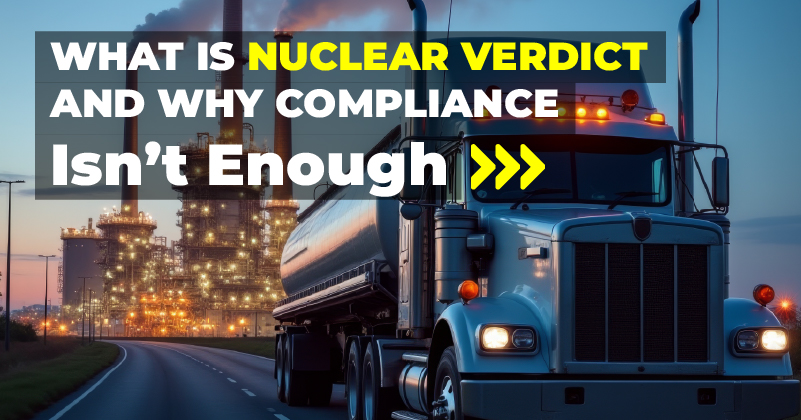
The term “nuclear verdict” refers to extraordinarily high damage awards, typically exceeding $10 million. These verdicts often seem irrational and can have devastating impacts on industries, particularly the trucking industry. Understanding the factors contributing to nuclear verdicts and implementing comprehensive safety measures is crucial to mitigating these risks. In this blog we’ll learn what is nuclear verdict and why compliance isn’t enough.
What is a Nuclear Verdict?
Nuclear verdicts are legal judgments with damage awards that far exceed typical compensation levels. These awards often surpass $10 million and are characterized by their seemingly irrational and excessive nature. While large verdicts have been around for decades, the term “nuclear verdict” has gained prominence in recent years, especially as verdict amounts have skyrocketed.
Historical Context of Nuclear Verdicts
Nuclear verdicts have been a part of the legal landscape since at least the 1980s. A notable example is the 1984 Agent Orange settlement, where the manufacturer was ordered to pay $180 million. Another significant case was the $10.5 billion settlement in favor of an oil company in a business dispute in 1985. Over time, these high verdicts have only increased in frequency and size, such as the $150 billion awarded in a 2011 case involving a burn victim.
The Impact on the Trucking Industry
The trucking industry is particularly vulnerable to nuclear verdicts. These astronomical awards can cripple companies, especially smaller ones, leading to increased costs for insurance, shipping, and ultimately, consumers. For example, a 2021 Florida case resulted in a $1 billion verdict against two trucking companies, highlighting the severe financial consequences of such rulings.
The Billion-Dollar Trucking Verdict
In 2021, a jury awarded a staggering $1 billion verdict against Kahkashan Carriers and AJD Business Services. This verdict, driven by the tragic loss of a Florida college student, exemplifies the financial devastation that nuclear verdicts can impose. The verdict was divided between the two companies, with Kahkashan and its driver responsible for $900 million and $100 million, respectively.
The Reptile Theory: A Powerful Legal Strategy
Reptile Theory is a legal strategy that taps into jurors’ primal fears, urging them to render verdicts based on emotion rather than reason. This approach was popularized by the book “Reptile: The 2009 Manual of the Plaintiff’s Revolution” by Don Keenan and David Ball. The theory argues that by making jurors feel personally threatened, they will respond with disproportionately high verdicts. This strategy has contributed to the rise in nuclear verdicts, as seen in cases involving severe injuries or fatalities.
The Role of Litigation Funding
Litigation funding has emerged as another driver of nuclear verdicts. This practice involves third-party investors financing lawsuits in exchange for a share of the settlement. While this can provide plaintiffs with the resources needed to pursue their cases, it also encourages exorbitant settlements and verdicts, further inflating the potential financial impact on defendants.
Economic Ripple Effects
Nuclear verdicts have far-reaching economic consequences. They increase costs for trucking companies, which are then passed on to customers and consumers. Higher insurance premiums, increased shipping rates, and the potential for industry consolidation are just a few of the ripple effects. Smaller trucking companies may struggle to survive after a nuclear verdict, leading to a less competitive market and higher prices for goods and services.
Compliance vs. Proactive Safety Measures
A common misconception is that operating a fleet compliant with Federal Motor Carrier Safety Administration (FMCSA) regulations is sufficient to avoid nuclear verdicts. However, compliance alone is not enough. Plaintiff attorneys often argue that merely meeting regulatory standards indicates a lack of proactive safety measures, portraying the company as either indifferent or incompetent.
The Importance of Duty of Care
The legal concept of “duty of care” plays a crucial role in nuclear verdicts. This principle requires individuals and companies to act with the watchfulness, attention, caution, and prudence that a reasonable person would exercise in similar circumstances. Failure to meet this standard can result in a finding of negligence, leading to significant punitive damages.
Strategies to Protect Against Nuclear Verdicts
To protect against nuclear verdicts, companies must go beyond compliance and demonstrate a genuine commitment to safety. This involves investing in proven safety technologies and programs, such as video-based safety systems, driver training, and continuous monitoring of safety performance. By proactively addressing safety concerns, companies can reduce the risk of severe accidents and, consequently, nuclear verdicts.
The Role of Safety Directors
Safety directors play a pivotal role in mitigating the risk of nuclear verdicts. They must be well-informed about the latest safety technologies and practices and ensure their implementation within the company. During litigation, safety directors may be questioned about their knowledge and actions. Demonstrating a proactive approach to safety can significantly impact the outcome of such cases.
Implementing Video-Based Safety Systems
Video-based safety systems are a valuable tool in preventing accidents and protecting against nuclear verdicts. These systems provide real-time monitoring of driver behavior, allowing for immediate corrective actions. They also offer crucial evidence in the event of an accident, helping to establish the facts and potentially mitigating liability.
Continuous Driver Training
Ongoing driver training is essential for maintaining high safety standards. Regular training sessions can help drivers stay updated on best practices, new regulations, and emerging safety technologies. By investing in continuous education, companies can demonstrate their commitment to safety and reduce the likelihood of accidents.
Monitoring Safety Performance
Continuous monitoring of safety performance is critical for identifying potential issues before they lead to accidents. Implementing a comprehensive safety management system allows companies to track key metrics, such as accident rates, near-misses, and compliance with safety protocols. This data-driven approach enables proactive interventions and continuous improvement.
Engaging with Legal Counsel
Proactive engagement with legal counsel is crucial for developing strategies to mitigate the risk of nuclear verdicts. Experienced attorneys can provide guidance on best practices, help companies understand their legal obligations, and develop robust defense strategies. Regular consultations with legal experts can also help identify potential vulnerabilities and address them before they become legal liabilities.
Building a Culture of Safety
Creating a culture of safety within the organization is essential for reducing the risk of nuclear verdicts. This involves fostering an environment where safety is a top priority and employees are encouraged to report potential hazards without fear of retribution. Leadership must actively promote safety initiatives and lead by example to instill a strong safety culture.
Investing in Technology and Innovation
Investing in the latest safety technologies and innovations is a key strategy for mitigating the risk of nuclear verdicts. Advanced driver assistance systems (ADAS), automated braking systems, and telematics are just a few examples of technologies that can enhance safety and reduce the likelihood of severe accidents.
Addressing Fatigue and Driver Wellness
Driver fatigue is a significant contributor to accidents in the trucking industry. Implementing policies and technologies to monitor and manage driver fatigue is crucial for preventing accidents. Promoting driver wellness through initiatives such as health programs, regular medical check-ups, and mental health support can also contribute to overall safety.
Collaborating with Industry Partners
Collaboration with industry partners, such as insurance companies, technology providers, and safety organizations, can enhance a company’s safety efforts. These partnerships can provide access to valuable resources, expertise, and funding for safety initiatives. Engaging with industry stakeholders can also help companies stay informed about emerging trends and best practices.
Adapting to Regulatory Changes
Staying informed about regulatory changes and adapting to new requirements is essential for maintaining compliance and demonstrating a commitment to safety. Companies must regularly review and update their policies and procedures to align with the latest regulations and industry standards.
Preparing for Post-Crash Litigation
In the event of an accident, thorough preparation for post-crash litigation is critical. This includes preserving evidence, conducting thorough investigations, and engaging with legal counsel to develop a robust defense strategy. By being prepared, companies can better navigate the legal process and potentially mitigate the impact of a nuclear verdict.
External Resources and Expert Consultation
Engaging external resources and experts can provide valuable insights and support for improving safety and mitigating risks. This includes consulting with safety experts, attending industry conferences, and participating in safety training programs. Leveraging external expertise can help companies stay ahead of emerging trends and implement best practices.
Conclusion
Compliance with FMCSA regulations is necessary but not sufficient to protect against nuclear verdicts. To truly safeguard against these exorbitant awards, companies must proactively invest in safety technologies and programs, create a strong culture of safety, and engage with legal counsel and industry partners. By doing so, they can reduce the risk of severe accidents and demonstrate their commitment to the highest safety standards.
Incorporating a Transportation Management System (TMS) like TMS-Digital can further enhance safety and efficiency by providing comprehensive oversight and management of logistics operations. To learn more about protecting your business and improving safety, explore TMS-Digital and other innovative solutions.










